Affiliate links on Android Authority may earn us a commission. Learn more.
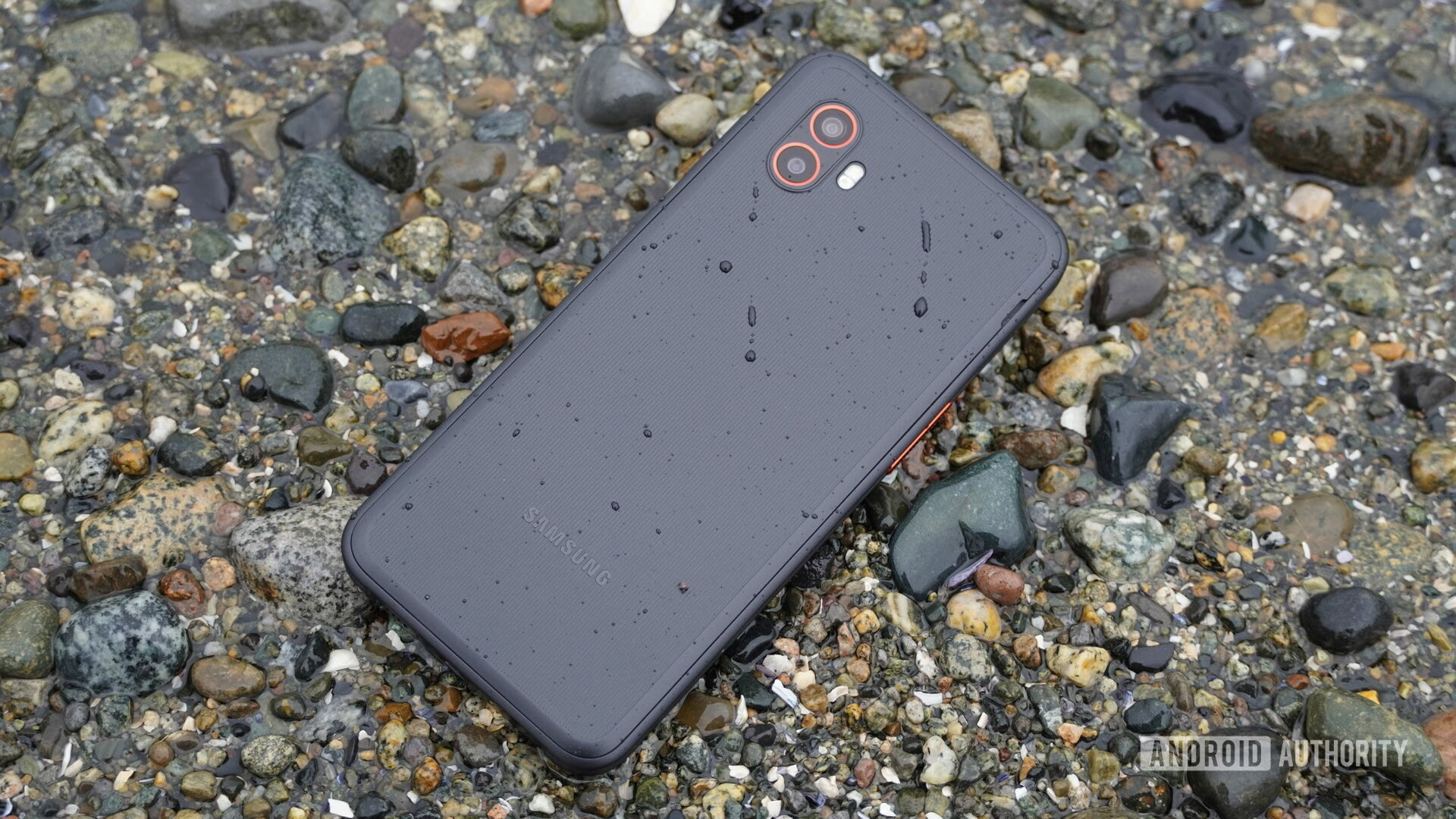

Samsung Galaxy XCover 6 Pro review: Rugged refined
Published onApril 4, 2024

Samsung Galaxy XCover 6 Pro
What we like
What we don't like

Samsung Galaxy XCover 6 Pro
The best phones are getting thinner, lighter, and all the more fragile with every passing year. That’s okay for those of us who work in offices or the comfort of our homes, but it limits the choice for anyone working in harsher environments. Most of the rugged phones on the market are big and bulky, designed to take a beating. But with the Galaxy XCover 6 Pro, Samsung aims to offer something different for the target audience; a sleek, simple phone that doesn’t skimp on durability and brings back some sought-after features. Does it succeed in delivering the best of both worlds? Find out in Android Authority’s Samsung Galaxy XCover 6 Pro review.
Update, April 2024: We’ve updated this review with the latest software information and new alternatives.
What you need to know about the Samsung Galaxy XCover 6 Pro
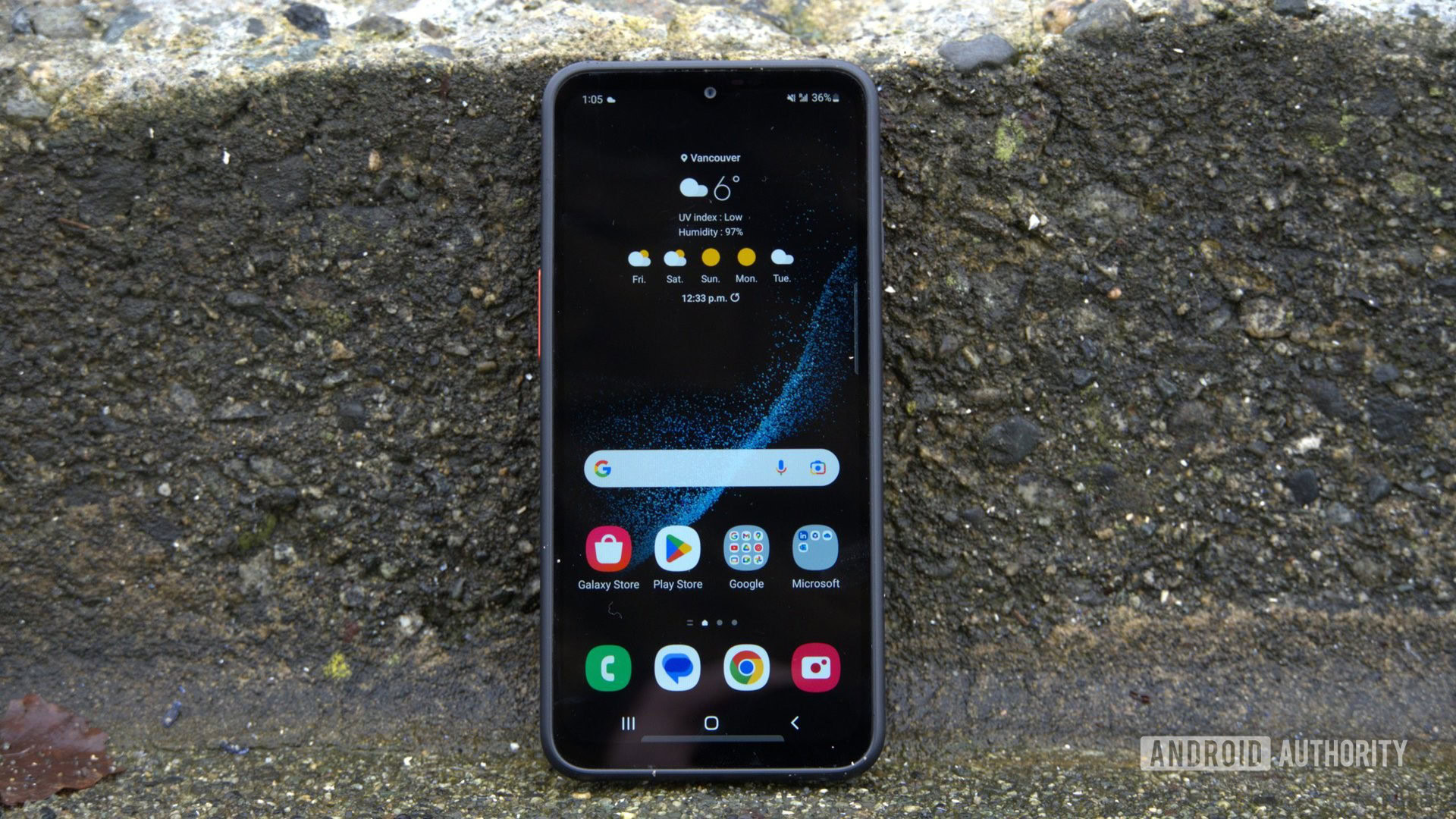
- Samsung Galaxy XCover 6 Pro (6GB/128GB): $599 / £589 / €609
The Galaxy XCover 6 Pro is a durable mid-range phone designed to withstand drops, dirt, and spills. In the rugged device market, the Samsung Galaxy XCover 6 Pro is priced a bit higher than many of its competitors, but it has a few unique things going for it. Most notably, it’s one of the very few phones nowadays to have a removable battery that can be swapped out in seconds. It also has dual-SIM support, and you can add an extra 1TB of storage through the included microSD card slot.
Only one Galaxy XCover 6 Pro version is available, with a Qualcomm Snapdragon 778G processor under the hood. Aside from the upgraded chipset, there are a few notable improvements over its predecessor, the Galaxy XCover Pro, including support for 5G and Wi-Fi 6E for high-speed connectivity. It also has twice the storage at 128 GB and better rear-camera resolution with a 50MP shooter compared to the 25MP on the XCover Pro.
While you can find cheaper rugged phones, having one from a well-known brand like Samsung has certain benefits. For instance, the Galaxy XCover 6 Pro ran Android 12 with Samsung’s One UI 4.1 out of the box, but can be updated to Android 14 with One UI 6. It also has a comprehensive update policy for any phone: four Android upgrades and five years of security patches. Samsung DeX support is also provided so the XCover 6 Pro can be the brains behind a larger display experience using an HDMI or USB-C cable. Speaking of, there is an included USB cable, but like many of Samsung’s other phones, there is no power adapter in the box.
Next to the uncovered USB-C port, you’ll find two POGO pins and a single firing speaker on the bottom. There’s a textured smart key on the phone’s left side and another programable button on the top, next to a 3.5mm headphone jack. The right side houses the volume rocker and power/fingerprint sensor button.
The Galaxy XCover 6 Pro was released in July 2022 and is available in the US through Amazon or directly from Samsung. It is also available in the UK, throughout the rest of Europe, and in select regions in Asia.
What’s good?
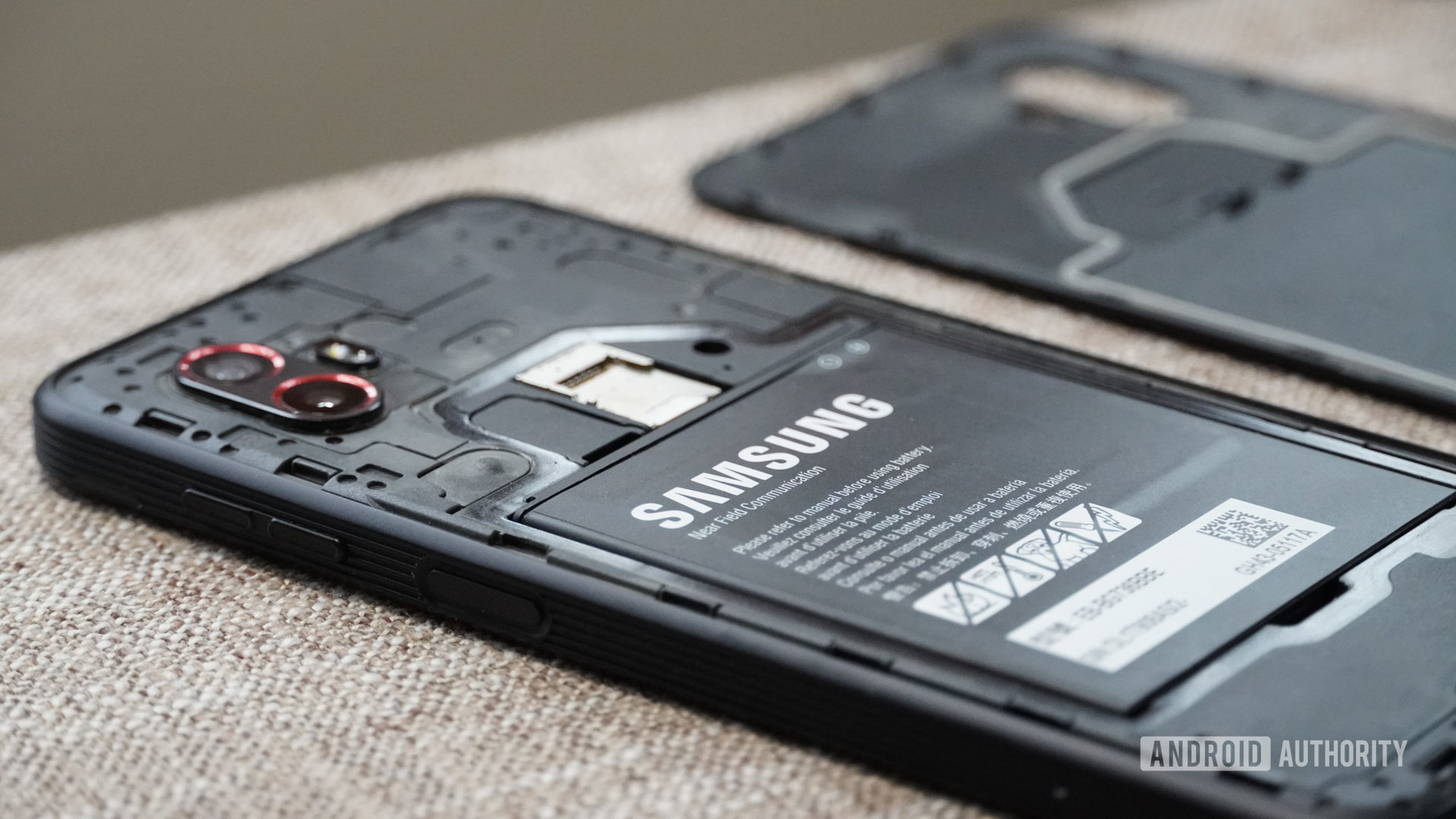
Unlike most rugged phones that are big and bulky, the Galaxy XCover 6 Pro carries on the XCover series’ habit of offering a sleeker, streamlined design. It’s like a rugged phone disguised as a normal phone, so it doesn’t stand out. While I appreciate the subtlety, the target audience may not care about the slim form factor as much. The function, after all, is ultimately what matters for outdoor and industrial settings, but the XCover 6 Pro comes prepared.
For starters, the XCover 6 Pro has Gorilla Glass Victus Plus display protection — the same glass you find on the Galaxy S22 series. There’s also IP68 water and dust resistance and a MIL-STD-810H certified design, meaning it can withstand various environmental conditions, including high and low temperatures, shock, vibration, and low pressure or high altitudes. All that amounted to the Galaxy XCover 6 Pro handling almost everything I threw at it.
I never worried about the screen getting scratched or cracked, even without a case.
In our testing, I dropped the phone from both my pocket and head height on different surfaces (I’m roughly six feet tall, for reference), sprayed it with water, and shook it around inside a box of coarse sand. Throughout it all, I never worried about the screen getting scratched or cracked, even without a screen protector. I wasn’t so confident about the durability of the thin plastic backside, but we’ll get to that later.
The removable rear cover is, however, one of the main selling points of this phone since it allows for a swappable battery. For those who need to use their phone for extended periods away from accessible power points, this feature is a must. It was quick and easy to swap out batteries when I needed a full charge or wanted to access the SIM card. Plus, this phone is compatible with the XCover Pro battery if you are upgrading from that device.
A large, removable 4,050mAh battery is an increasingly rare feature among phones, even rugged ones.
Considering the relatively small 4,050mAh battery, I was pleasantly surprised by the longevity of the XCover 6 Pro. It’s the same size battery as the previous XCover Pro. Most of my time spent using the phone consisted of social media, music listening, a bit of video streaming, and some light gaming, and I would end my days with roughly 20% of battery life left.
Under the hood is a Snapdragon 778G processor, a surprisingly impressive mid-tier chip for a rugged phone. It’s the same chipset in the much-loved Galaxy A52s and is the baby cousin to the 778G Plus found in the Nothing Phone 1. Paired with a healthy 6GB of RAM, the Galaxy XCover 6 Pro has no problems multitasking between apps. It also consumes power efficiently, so you won’t have any heating issues, provided you aren’t playing graphically-intense games for hours on end. Overall, this is a big improvement compared to the XCover Pro, which had the rather low-clocked Exynos 9611 chip coupled with a meager 4GB of RAM.
The benchmark scores aren’t going to compete with any of the top-end phones on the market, but they beat out Samsung’s mid-range Galaxy A53 5G and easily blow almost all other rugged phones out of the water. The only real exception is the Motorola ThinkPhone with its flagship-tier Snapdragon 8 Gen 1 SoC, but you’ll be spending at least $400 extra for the privilege. Whether you see the Galaxy XCover 6 Pro as an affordable phone with a durable shell or a rugged phone with a scrappy mid-range heart, it’s refreshing to see a reasonably-priced phone in this category that isn’t just physically tough but also delivers strong performance.
You’re getting a much nicer display than you would normally expect from a rugged phone too, but that’s totally on-brand for Samsung. The 6.6-inch LCD panel is bright with sharp contrasts and features a fast 120Hz refresh rate. There’s no PMW dimming either, so it can be easier on the eyes if you are sensitive to flickering.
It's refreshing to see a reasonably-priced rugged phone that isn't just physically tough but delivers strong performance as well.
Samsung has also included a “sensitive touchscreen” to better respond to gloved hands, dirty fingers, and wet palms. However, I did find myself having to press or swipe things twice on screen while wearing a typical pair of garden gloves, so it isn’t always 100% accurate. If you want to minimize swiping, the two assignable keys let you quickly access whichever features or apps you use most or keep a number on speed dial. I usually had the top key reserved for the flashlight and the side key to open my music streaming apps.
Below the volume controls, the power button/fingerprint reader combo is very fast and accurate, so much so that I rarely had the chance to input my pin to unlock the phone since it would quickly scan my thumbprint after turning it on. Though it may be obvious, this feature doesn’t have the sensitivity of the screen to work with gloves.
The Galaxy XCover 6 Pro also has an increasingly rare notification LED. It’s been a while since I used a phone with this feature, and I must say I forgot how useful it was. You can see the charge status or if a new notification is waiting for you from across the room, which can be less distracting than sounds and vibrations, yet get your attention better if you work in a loud environment.
What’s not so good?
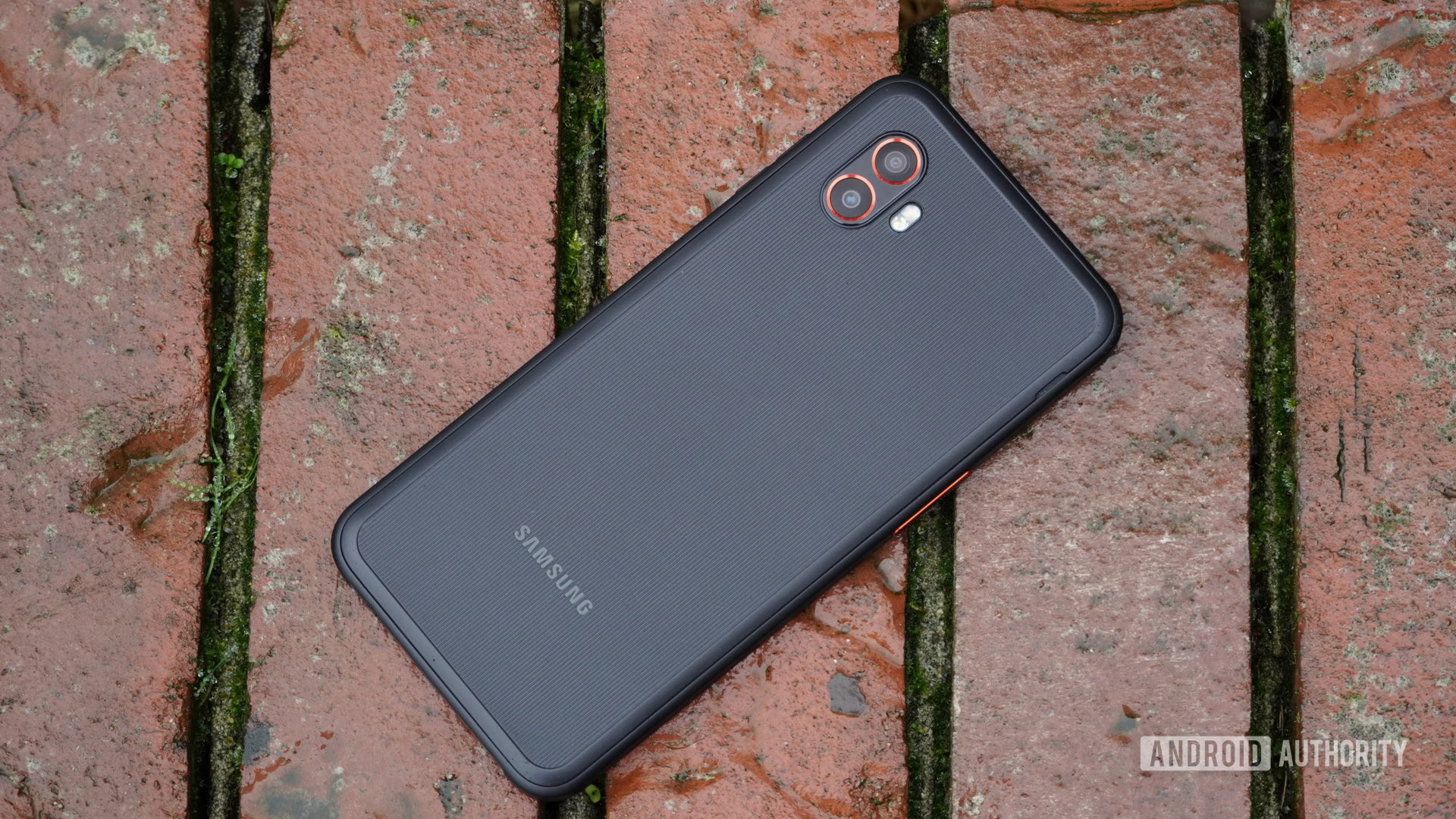
While there is a lot to love with this rugged phone, the Galaxy XCover 6 Pro is not without its downsides either. For starters, even though the battery life is decent, the charging capabilities are lacking. The device is limited to 15W wired charging through the usual USB-C port or using the phone’s POGO pins. The phone won’t run hot while charging, but it will take around two hours to recover from a depleted battery. There’s no support for wireless charging, either. While fairly rare for a rugged device, it would’ve been nice to see, considering the Galaxy XCover 6 Pro is a little pricier than its peers.
The Galaxy XCover 6 Pro's wired charging is limited to 15W, and there's no wireless charging.
Looking at the screen, the bezels around the display are pretty big. Again, this isn’t abnormal for a rugged phone, as it provides more structural integrity, but I’d recommend using dark mode since it won’t stand out as much at full brightness. The Galaxy XCover 6 Pro also has a tiny waterdrop notch. I wish Samsung had moved it slightly higher to hide it within the already-sizable bezel instead of having it dip down into the display.
Being an LCD display, there’s no always-on feature for this model, either. However, it has Lift to Wake, which only requires you to pick up the phone to turn on the screen. It may be a minor gripe, particularly as AMOLED displays are fairly rare in the rugged phone space, but it can be annoying if you want to leave the phone on to read something. At least the fast fingerprint scanner helps to unlock it quickly.
As I mentioned in the previous section, the removable plastic back cover is both a pro and a con for this phone, as it’s kind of the Achilles’ heel regarding durability. It definitely feels like the phone’s most brittle component, and I’d be worried about the result of anything heavy or sharp striking it. Additionally, even after ensuring the back side was firmly clicked in, a fine layer of dust made it’s way inside after swishing the phone around in the sand. That didn’t affect the phone’s performance during my usage, but it could if you have to deal with fine materials at work.
The plastic backside doesn't inspire much confidence in absorbing impacts. And being removable, dust can find its way inside.
Additionally, while this is a phone that’s made to handle getting messy, it isn’t one that’s designed to be easy to clean. The ridges around the side are intended to help with grip but trap a lot of dust debris. You may need a toothpick to clean them out after a while. Between that and the not-so-sealed backside, one compromise would be to use a thin rubber case. That way, you ensure the backside is always sealed, and you can peel it off for quick access. Plus, rubber would improve the grip, as this phone did feel pretty slippery in wet conditions.
Lastly, the built-in mono-audio speaker isn’t anything to write home about. Videos and music sound okay at low volumes, but if you want to show something to a group of people, turning the volume up all the way sees, the audio start to echo, causing the phone to vibrate slightly and sound quite scratchy on the ears. You’ll have a much better listening experience using the headphone jack or wireless earbuds.
Samsung Galaxy XCover 6 Pro camera review
The Galaxy XCover 6 Pro has decent onboard cameras that compete with other offerings in the rugged genre. Most rugged phones have rear shooters between 12MP and 48MP, but the XCover 6 Pro boasts a 50MP primary camera and an 8MP ultrawide lens on the backside. The colors, details, and exposure from the 50MP primary camera are all pretty crisp, partially with the help of HDR support. But some pictures, both indoors and outdoors, did tend to have a pinkish tint to them. This is likely an issue with the software’s white-balancing, but it won’t affect the clarity of objects.
The 13MP selfie shooter is pretty good at capturing facial details, and the portrait effects are tame enough to soften the background without making the edges around you too fuzzy. However, capturing details at a distance is another story, as the XCover 6 Pro does not support OIS (optical image stabilization) or optical zoom. Using the rear cameras at 4x zoom, the details are not terrible but become blurred. At 10x zoom, you will lose the autofocus completely, and things will become blurred and blended.
The 8MP ultrawide camera is fairly reliable at capturing more of the scene, whether up close or at a distance. As expected, there is a bit of fish-eye lens distortion, with some lines warped at the edges. But it still maintains the same color consistency and auto-focus as the primary shooter, which is a plus.
As for the video quality, the XCover 6 Pro can record 4K video up to 30 fps, whereas the XCover Pro was limited to 1080p at 30 fps. Footage captured from the primary sensor is reasonably steady, despite the lack of OIS, but you may notice a few frame rate stutters. This isn’t the phone to get for serious videography, but it can capture a quick video for work purposes and is equally acceptable for a short clip for social media.
Samsung Galaxy XCover 6 Pro specs
| Samsung Galaxy XCover 6 Pro | |
|---|---|
Display | 6.6 inch LCD 1080 x 2408 120Hz refresh rate 20:9 aspect ratio |
Processor | Qualcomm SM7325 Snapdragon 778G |
GPU | Adreno 642L |
RAM | 6GB |
Storage | 128GB microSDXC |
Cameras | Rear: 50 MP, f/1.8, (wide), 1/2.76", PDAF 8 MP (ultrawide) 8 MP, f/2.2, 123˚ (ultrawide), 1/4.0" Front: 32 MP f/2.2, (wide) |
Battery | 4,050mAh 15W wired charging |
Audio | Loudspeaker 3.5 mm headphone jack |
IP Rating | IP68 |
Sensors | Fingerprint (side-mounted), accelerometer, gyro, proximity, compass, barometer Samsung DeX support |
Network | LTE / 5G |
Connectivity | Wi-Fi 6E Bluetooth 5.2 GPS |
SIM | Dual (Nano + one eSIM) |
Software | Samsung One UI 4.1 Android 12 |
Dimensions and Weight | 168.8 x 79.9 x 9.9 mm (6.65 x 3.15 x 0.39 in) 235 g (8.29 oz) |
Colors | Black |
Samsung Galaxy XCover 6 Pro review: The verdict
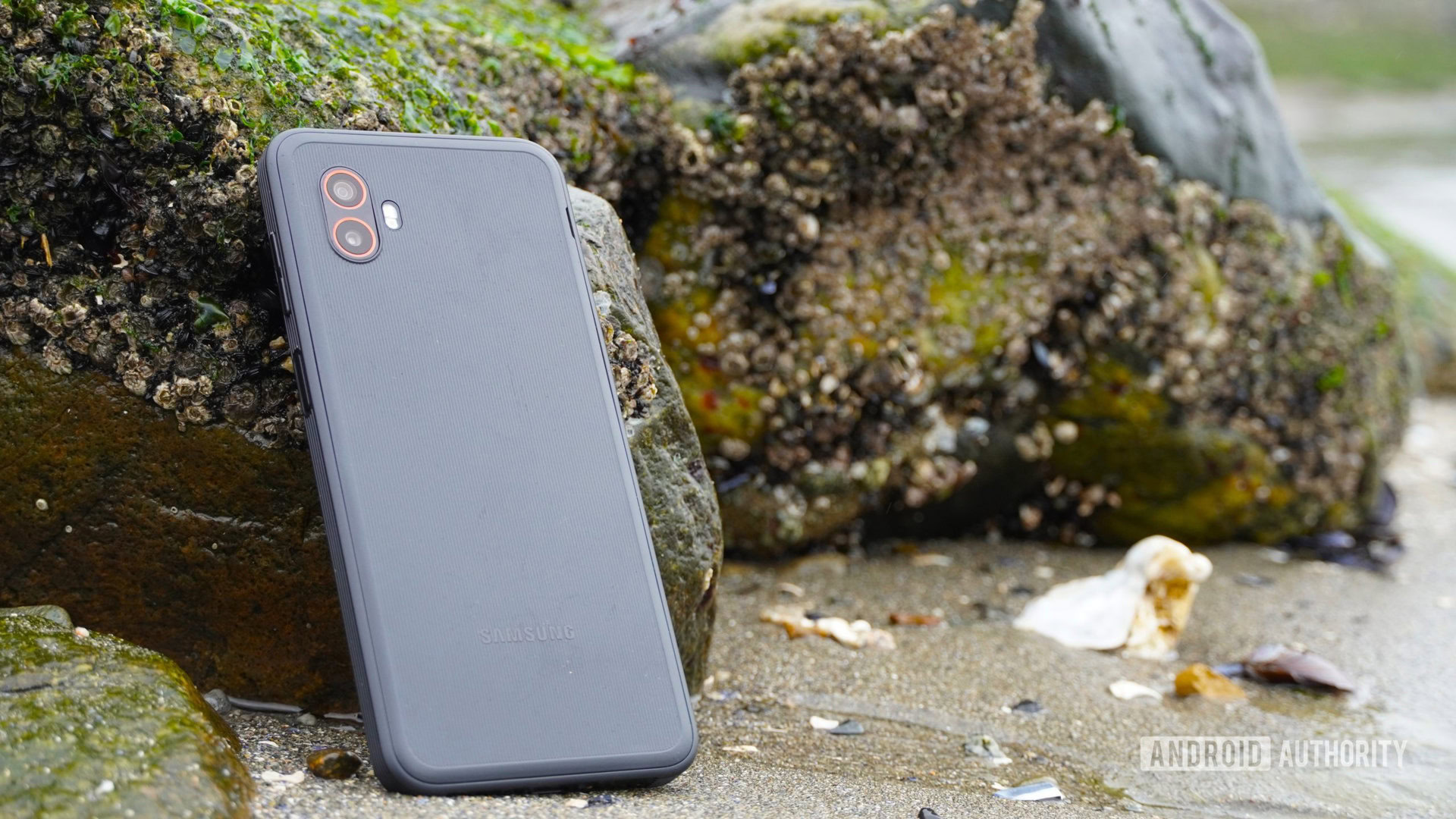
Does Samsung succeed in making a sleek phone that’s as durable as its bulky competitors? The short answer is almost. While the Gorilla Glass Victus Plus on the front display is plenty strong and it has all the top-tier certifications for a durable device, the plastic backside won’t be able to take nearly as many blows. Samsung may have avoided that had it gone for a rubberized or metal approach, but such is the catch-22 of having a removable plastic back so you can swap out the battery.
For myself, the unique advantages of the Galaxy XCover 6 Pro easily outweigh not having the utmost durability, making it one of the most attractive options in the rugged phone arena. Being a Samsung phone, there’s no shortage of software longevity and usability, and I appreciated the revival of practical features such as the LED indicator, headphone jack, and customizable buttons. The smooth performance is also a real boon over the competition, which tend to be sluggish to use.
Compared to the more expensive, aging, and yet still very popular Cat S62 Pro ($549 at Amazon), the XCover 6 Pro is equally durable, with the advantage of 5G connectivity, a long-term update policy, a better processor, and a slightly bigger battery — though it doesn’t have a thermal imaging camera. The somewhat cheaper Nokia XR20 ($349 at Amazon) is a little more stylish, with the same durability standards, and has a bigger battery and faster charging. Still, its Snapdragon 480 chipset lags well behind the XCover6 Pro’s 778 chip, and the fingerprint reader isn’t as fast or consistent.
Looking within Samsung’s own lineup, the company debuted the XCover 7 in early 2024. The rugged phone swaps the XCover 6 Pro’s Snapdragon chipset for a MediaTek Dimensity 6100 Plus, offers Android 14 out of the box, and includes a lower-resolution selfie camera. Considering its entire specs sheet, it’s not a direct successor to the XCover 6 Pro and is priced at £349 in the UK. There are no official US pricing details just yet, but if you can find it, it may be a worthwhile newer budget alternative.
While it's not the most durable phone out there, the XCover 6 Pro is a sleek daily driver with solid mid-range specs for those who need a little extra protection.
If you tend to drop your phone a lot, don’t want to use a phone case, and don’t care for the most premium cameras, then the XCover 6 Pro is a dependable daily driver. If that’s enough for you and you aren’t planning to upgrade your phone for a while, I can see the XCover 6 Pro lasting for several years without hardware breakage or performance slow-down, backed by extensive software support.
On the other hand, if you need something more durable for extreme working conditions and don’t care about how your phone looks or performs, you might want to check out the sturdiest options on our best rugged phones list.


Top Samsung Galaxy XCover 6 Pro questions and answers
The Samsung Galaxy XCover 6 Pro launched on September 20, 2022.
Yes, the Samsung Galaxy XCover 6 Pro has an IP68 water resistance rating, meaning it can withstand up to five feet of fresh water for up to 30 minutes.
The Galaxy XCover 6 Pro is pretty durable, but the removable plastic backside can allow dirt and water to seep in if not fully sealed. You may want to get a case if you often swap batteries in and out.
Unfortunately, the XCover 6 Pro does not support wireless charging. It is limited to 15W wired charging via the USB-C port or using the phone’s POGO pins.
Yes, the Galaxy XCover 6 Pro supports 5G connectivity (sub-6GHz only).
At the time of writing, the Galaxy XCover 6 Pro is the most durable phone in Samsung’s lineup, thanks to its MIL-STD-810H certified design.